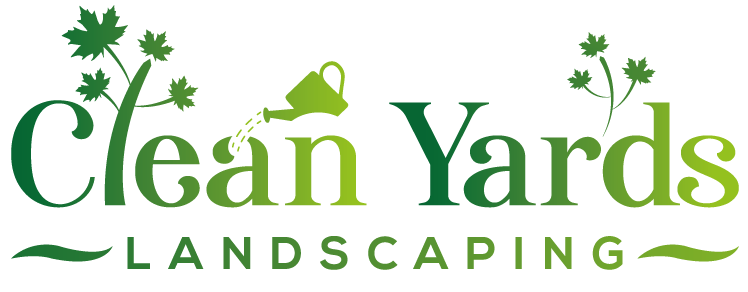Kenmore Rainwater Harvesting: Save $$ & Water This Spring
Quick Guide to Rainwater Harvesting in Kenmore:
- Capture free rainwater from your roof using simple rain barrels.
- Save money on municipal water bills, especially for outdoor use.
- Provide naturally soft, chlorine-free water that plants love.
- Reduce stormwater runoff and help protect local waterways.
- Easy DIY setup for basic rain barrels.
- Essential winter maintenance required in Ottawa climate.
Ready to make your yard more sustainable and save money? Request a quote for our landscaping and yard care services today!
Introduction: Hello Kenmore! Let's Talk Rain (and Saving Money!)
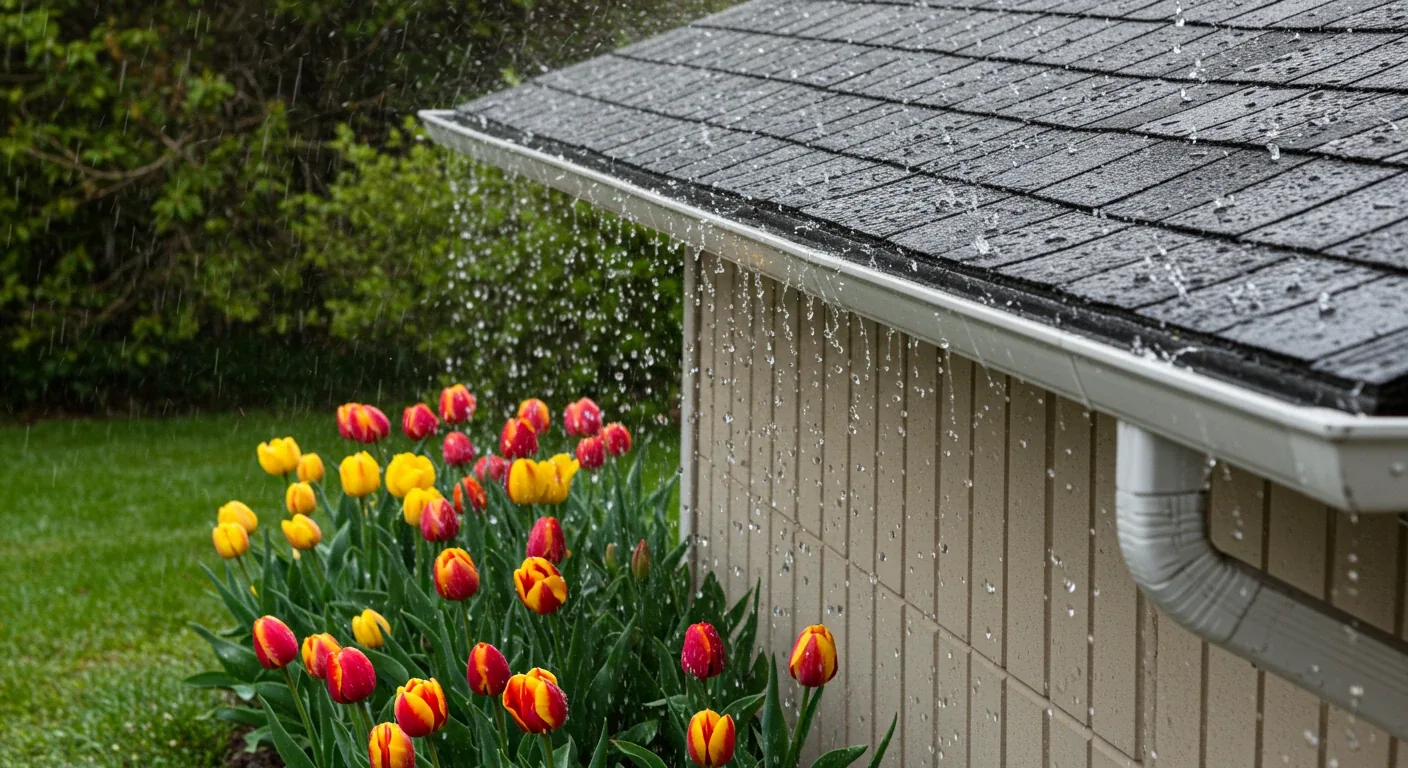
Hello Kenmore! Spring has sprung across the Ottawa region, from here all the way out to neighbours in Manotick and Greely! That means warmer days, greener gardens waking up, and let's be honest, our fair share of glorious spring showers. Ever watch all that rain pouring off your roof and think, "There goes perfectly good water... straight into the storm drain"? It feels like a waste, right? What if you could put that free H2O to fantastic use for your landscaping projects and actually save money on your water bill at the same time?
Enter rainwater harvesting! It might sound a bit technical, but it’s often as straightforward as setting up a simple rain barrel under a downspout. Capturing rain is a super practical, earth-friendly way to practice water conservation (check out tips from the City of Ottawa). Plus, your garden plants and lawn often prefer natural rainwater (it's naturally soft and free of chlorine!). It’s perfect for watering flowers, washing the car, or topping up ponds without turning on the tap. Let's dive into how this simple, smart idea can make a big difference for your Kenmore home – and your wallet! – this gardening season.
What Exactly is Rainwater Harvesting and Why Should Ottawans Care?
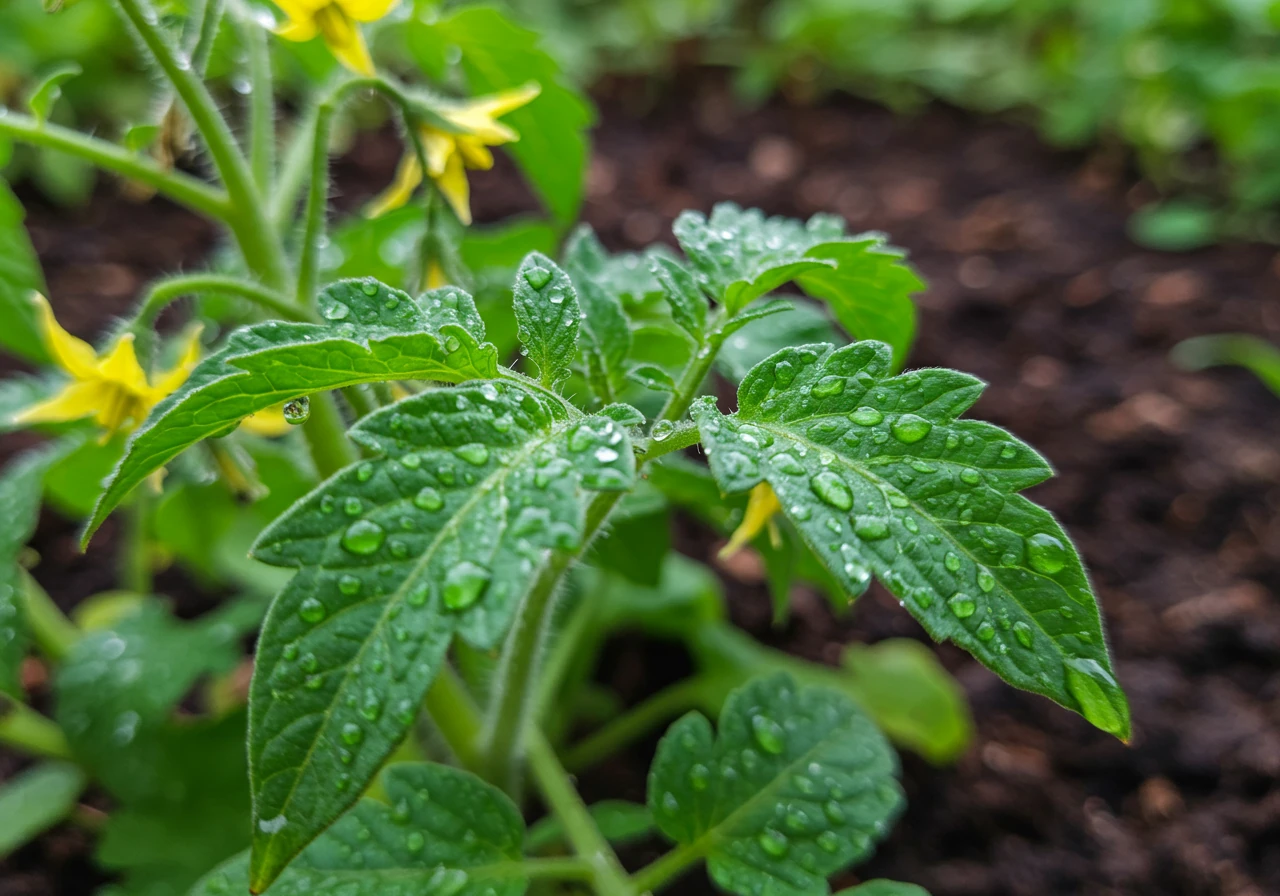
Alright, let's break down "rainwater harvesting." Fancy term, simple idea! Think of it like this: instead of letting all that lovely rain roll off your roof, down the driveway, and into the storm sewer (bye-bye, free water!), you actively catch it and save it for later. It’s essentially collecting the precipitation that lands on your property – usually from your roof via eavestroughs and downspouts – and storing it in a container, most commonly a rain barrel, but sometimes larger tanks for the seriously committed harvester!
It's not some wacky new invention; people have been doing this for centuries. But it's making a smart comeback, especially here in Ottawa. So, why should you, whether you're tending a garden in Kenmore or enjoying a larger property out in Manotick, actually care about catching rain? There are some fantastic reasons:
- Your Wallet Will Whisper Sweet Nothings: Let's be real, Ottawa water bills aren't exactly pocket change. Every time you water your lawn, rinse your gardening tools, or give your prize-winning tomatoes a drink using harvested rainwater, you're not paying for municipal water. Especially during those sometimes surprisingly dry summer stretches we get, using free rainwater for outdoor tasks can make a noticeable dent in your bill. Think of the savings! Maybe it's enough to finally tackle that landscaping project you've been dreaming about, or get some help with seasonal chores like those detailed in our guide to Kenmore Fall Perennial Division Garden Tips.
- Your Garden Will Do a Happy Dance: Believe it or not, your plants often prefer rainwater! Tap water is treated with chlorine and can contain minerals that aren't always ideal for sensitive plant roots or soil balance. Rainwater is naturally soft, slightly acidic, and free of these additives. It's like a spa day for your petunias, your vegetable patch, and even your lawn. Healthier plants are often more resilient, which is a bonus when it comes time for Kenmore Fall Guide: Plant Winter Prep. Plus, using rainwater complements other good lawn care practices, like following a solid Kenmore Lawn Care Spring Fertilizing Guide.
- You'll Be an Environmental Superhero (Cape Optional): When we get those classic Ottawa downpours, huge amounts of water rush off hard surfaces like roofs and driveways, overwhelming storm drains. This "stormwater runoff" picks up pollutants (oil, fertilizer, pet waste – ew!) and carries them directly into our beautiful local waterways, like the Rideau or Ottawa Rivers (learn more from the Rideau Valley Conservation Authority). By capturing rain on your property, you slow down this runoff, reduce the pollution load, and help prevent localized flooding or soggy yard syndrome. Managing excess water is crucial for property health; sometimes it requires professional help like Kenmore Fall Grading & Drainage Solutions, but every bit of harvested rainwater helps lessen the overall burden.
- It Eases the Strain on City Resources: During peak summer demand, all that outdoor watering puts a significant strain on Ottawa's water treatment plants and distribution systems. Practicing water conservation through rainwater harvesting helps reduce this peak load, which benefits the whole community. More resources can be found at local organizations like EnviroCentre Ottawa.
Basically, rainwater harvesting is a win-win-win: good for your budget, great for your garden, and kind to our local Ottawa environment. It’s a simple, practical step towards a more sustainable yard. And if you need a hand keeping that yard looking sharp, whether it's routine gardening or a bigger project, remember our Kenmore Garden Clean Up Service and other professional Landscaping and Yard Services are here to help!
Dip Your Toes In: Easy Rain Barrel Setup for Your Kenmore Home
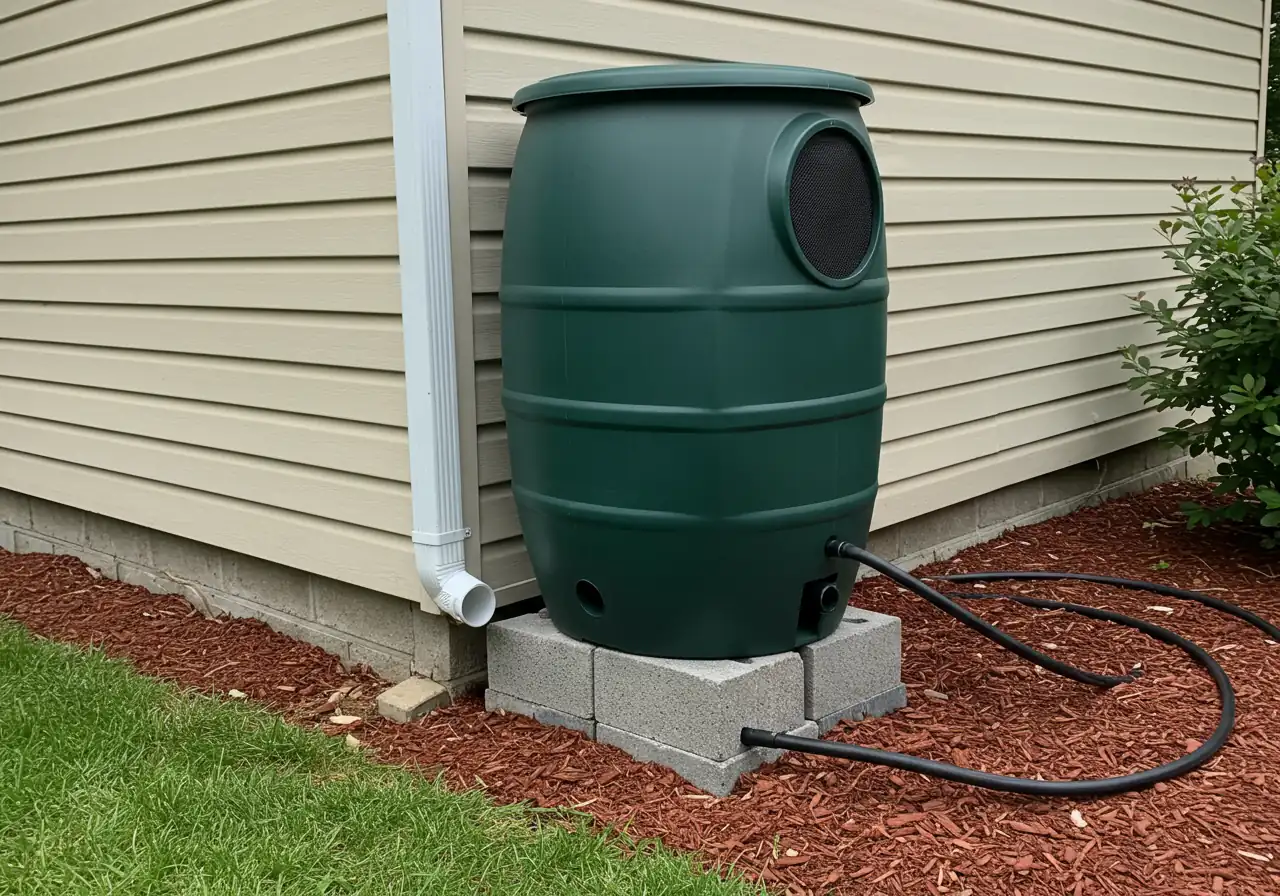
Okay, Kenmore neighbours, feeling inspired to try rainwater harvesting but worried it’s complicated? Relax! Setting up a basic rain barrel is surprisingly easy – think weekend afternoon project, not major landscaping overhaul. It’s a fantastic way to get started with water conservation right here in the Ottawa area. Let’s walk through how you can get your very own rain-catching system up and running.
Step 1: Choose Your Weapon... I Mean, Barrel!
First things first, you need a rain barrel. You can buy fancy pre-made ones or even DIY one (though pre-made is usually easier for beginners). Here’s what to consider:
- Size Matters: How much roof area drains to your chosen downspout? A tiny shed might only need a small barrel, while a large roof section on a typical Kenmore or Greely property might fill a standard 200-litre (about 55-gallon) barrel surprisingly fast in a good downpour. Homes on tighter lots, maybe like some in Barrhaven, might prioritize slimmer designs.
- Material: Most are durable, UV-resistant plastic. You'll find various colours and even some designed to look like stone or wood. Consider the aesthetics and longevity – good material selection pays off.
- Features: Look for a screened inlet (keeps leaves and mosquitoes out!), a spigot near the bottom for attaching a hose, and an overflow outlet near the top.
Step 2: Location, Location, Location
Find a downspout that’s convenient for where you’ll use the water most – likely near your gardening beds or favourite patch of lawn. Crucially, the spot must allow the barrel to sit on a level surface and ensure the overflow directs water away from your home's foundation. Seriously, don’t skip this part. Pooling water near your foundation is a big no-no.
Step 3: The Setup Shuffle
Ready? Let's do this!
- Create a Level Base: Rain barrels get heavy when full (water weighs about 1kg per litre!). Place solid cinder blocks or patio pavers where the barrel will sit to create a stable, level platform. Raising it also improves water pressure from the spigot.
- Modify Your Downspout: This is often the trickiest bit, but still manageable.
- Place the barrel on its base next to the downspout. Mark the downspout about 5-10 cm above the barrel's inlet screen height.
- Carefully cut the downspout at your mark (a hacksaw works well). You might need sturdy gloves!
- Attach a flexible downspout elbow or a rain barrel diverter kit (available at hardware stores) to the cut end, directing water into the barrel's top screen. Diverters are great as they often handle overflow automatically back into the lower downspout section.
- Connect the Overflow: Attach a hose to the barrel's overflow outlet. Make sure this hose is long enough to carry excess water several feet away from your foundation, ideally towards a garden bed that can handle extra moisture or just onto the lawn downhill from the house.
- Check Connections: Ensure everything fits snugly.
Step 4: Safety & Use
Keep that inlet screen clear of debris! This prevents clogs and stops mosquitoes from turning your barrel into a nursery. Using the water is simple: attach a hose to the spigot or fill a watering can directly. Remember, the water pressure won't be like your outdoor tap; it relies on gravity.
That’s it! You’re harvesting rain. It’s a small step that makes a difference. If yard tasks like this, or bigger projects like seasonal property clean up, feel a bit much, remember help is available. Our team offers services like the Kenmore Garden Clean Up Service, and you can always book an estimate to discuss your needs. We respect your information; you can review our privacy policy anytime. Now, go catch some rain – and send a little thank you note to the clouds!
Benefits of Using Rainwater
Harvested rainwater is naturally soft, slightly acidic, and free from chlorine and other municipal water treatment chemicals. This makes it ideal for:
- Watering delicate flowers and vegetables.
- Nurturing seedlings and newly planted shrubs.
- Washing cars and windows without leaving mineral spots.
- Reducing your reliance on treated tap water for outdoor tasks.
Key Setup Reminders
- Level Base: Essential for stability when the barrel is full. Cinder blocks work well.
- Secure Connections: Ensure the downspout diverter/elbow fits snugly into the barrel inlet.
- Overflow Management: Direct the overflow hose well away from your home's foundation.
- Screen Protection: Always use the inlet screen to keep out debris and pests.
Year-Round Rain Barrel Care
- Spring: Clean and reconnect barrel. Check for leaks.
- Summer: Use water regularly. Keep screen clear. Monitor overflow.
- Fall: Continue use. Plan for winterization.
- Winter (CRITICAL): Before freezing temps, DRAIN completely, disconnect, and store empty (upside down or sheltered). Contact Ottawa Yard Cleanup Service for help with seasonal prep if needed.
Level Up Your Rain Game: Exploring Bigger Harvesting Systems
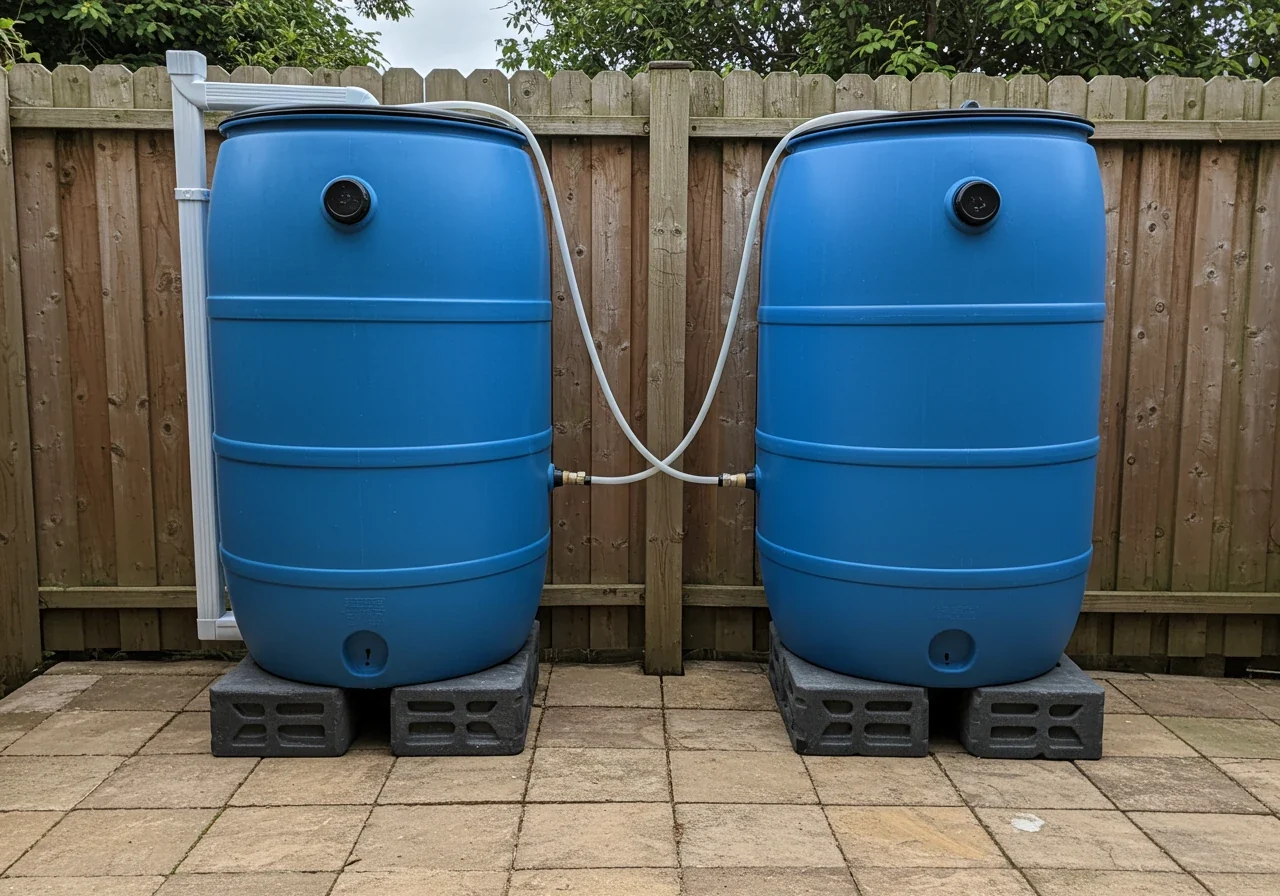
Okay, so you've got your rain barrel set up, maybe feeling a bit like a water conservation champ after mastering the basics? Awesome! But what happens when that one trusty barrel just isn't cutting it for your thirsty garden or ambitious landscaping dreams? Perhaps you've got a larger property, say out in lovely Richmond or spacious Metcalfe (where services like Metcalf Yard Cleanup Service might be familiar), and you're watching those Ottawa showers thinking, "I could be catching way more of this liquid gold!" If that sounds like you, it might be time to level up your rain game and explore bigger harvesting systems. Don't worry, it's not *always* super complicated, just requires a bit more planning.
One simple step up from a single barrel is linking multiple rain barrels together. It’s pretty much what it sounds like: you connect the overflow outlet of the first barrel to the inlet of the second one, and maybe even a third. Voilà! More storage capacity, using the same fundamental idea. This can be a great next step and often a manageable DIY project.
But if you're really serious about harnessing significant amounts of rainwater – enough to make a real dent in your outdoor water use – you might consider larger storage tanks, often called cisterns. These bad boys can range from several hundred litres (think multiple barrels combined) to massive underground vaults holding thousands of litres! Imagine having enough free, naturally soft water for extensive drip irrigation systems for that ambitious beautiful garden installation you've been planning, or easily washing down muddy equipment after a big seasonal property clean up. Having ample water on hand makes keeping those carefully mulched and edged beds perfectly moist much easier too. Need some visual inspiration for how these systems can integrate into a yard? Check out our project photo gallery.
Going bigger does come with a bit more homework, though. Keep these points in mind:
- Filtration Gets Fancier: With larger volumes, keeping the water clean becomes even more important. You might look into things like "first flush" diverters, which automatically discard the initial (often dirtier) runoff from your roof, and finer screens to keep out debris and prevent algae growth.
- Maintenance Matters: Like any home system, bigger rainwater tanks need regular upkeep. This includes checking filters, ensuring overflows are clear, and potentially periodic cleaning to remove any sediment. Think of it as part of your overall yard care routine, maybe alongside your regular Ottawa yard cleanup service. You can learn more about our company on the about us page.
- Check Ottawa Rules: Before you go digging a giant hole for an underground cistern, it’s crucial to check the City of Ottawa's regulations. There might be specific bylaws, permit requirements, or installation guidelines, especially for larger or more complex systems. Better safe than sorry! A good place to start might be the local horticultural society like the Ottawa Horticultural Society, as members might have experience.
Feeling intrigued by the potential but maybe a bit daunted by the bigger options? That's totally okay! Planning and installing larger rainwater harvesting systems can sometimes benefit from professional advice to ensure everything is sized, sited, and set up correctly for maximum benefit and safety. If you have questions about integrating these larger systems into your landscaping or need help figuring out the best approach for your specific Ottawa property, please feel free to contact us for more information. We're always happy to chat about smart ways to make the most of that glorious Ottawa rain! Perhaps check out our Google Business Profile for reviews and updates.
Making Every Drop Count: Using Your Harvested Rainwater Wisely
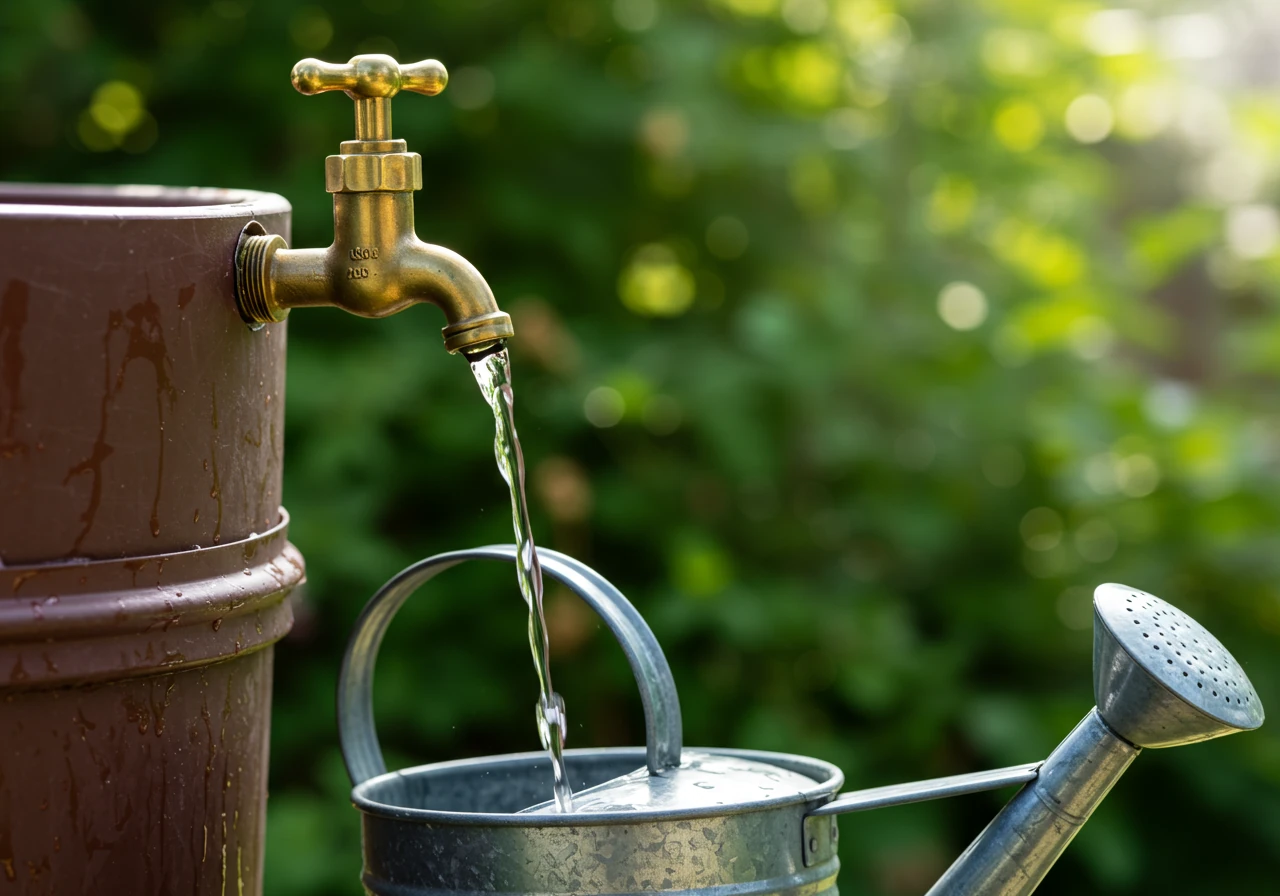
Fantastic! You've set up your rain barrel or maybe even a bigger system, and now you've got nature's finest beverage on tap (well, spigot!) for your yard. But just collecting it is half the fun; using that harvested rainwater wisely is where the real magic happens. Think of it as liquid gold for your landscaping efforts! Let’s dive into how to make every precious drop count, especially here in the Ottawa region.
What's This Water Good For, Anyway?
First things first: rainwater collected from your roof is amazing for most outdoor, non-drinking water needs. Your garden plants, in particular, will often prefer it over tap water because it's naturally soft and free of chlorine and other treatment chemicals.
Here are the prime candidates for a rainwater treat:
- Watering Garden Beds: Veggies, flowers, shrubs – they'll all soak it up. This free water is perfect when you're nurturing seedlings or tackling new planting projects that need consistent moisture, complementing good Soil Preparation techniques.
- Thirsty Container Plants: Pots and hanging baskets dry out quickly, especially in the summer sun. Rainwater is ideal for keeping them hydrated.
- Giving Your Lawn a Drink: While a barrel might not cover your whole lawn, it's great for spot-watering dry patches or giving new grass seed or sod a gentle start. It fits right in with a smart Lawn Care routine.
- Washing Tools & Equipment: Rinse off shovels, trowels, muddy boots, or even the lawnmower deck without using treated municipal water.
- Cleaning Outdoor Furniture & Windows: Perfect for a quick spring clean.
- Topping Up Ponds & Bird Baths: Wildlife appreciates the natural touch too!
Hold On, Is It Safe?
Good question! Rainwater collected from most common roof types (asphalt shingles, metal, tiles) is generally safe *for your plants and outdoor cleaning*. However, it's *not* considered potable (safe for drinking) without significant filtration and purification. It can pick up dust, pollen, bird droppings, and roofing material residue. So, while your roses will love it, stick to tap water for your tea! Keep the debris screen on your barrel clean to minimize gunk getting in. Need help with garden cleanup in other areas? We also offer Metcalf Garden Clean Up Service.
Your Ottawa Rainwater Harvesting Calendar:
Spring (April-May)
Setup time! Clean stored barrels, reconnect downspouts, check screens/spigots. Use initial rain for early gardening tasks. Consider pro help like Metcalf Property Cleanup Service if the yard needs major post-winter tidying.
Summer (June-August)
Peak watering! Use harvested water regularly, especially during dry spells. Keep inlet screens clear. Ensure overflow directs water safely away from foundation.
Fall (September-October)
Continue watering fall plants or bulbs. Start planning winterization as temps drop. This pairs well with fall cleanup from services like Marionville Property Cleanup Service.
Winter (November-March)
CRUCIAL: Before hard freeze (mid-Nov), DRAIN barrel completely. Disconnect from downspout. Store empty barrel (upside down/sheltered). Skipping this risks cracking! Like our Ottawa Property Cleanup Service, winter prep is key.
Show Me the Savings! (A Quick Estimate)
Curious how much water you might save? It's simpler than you think. Let's create a small example table:
| Barrel Size | Fills per Season (Estimate) | Total Litres Saved | Potential Impact |
|---|---|---|---|
| 200 Litres (Standard) | 10 | 2,000 Litres | Offsets moderate garden watering |
| 200 Litres (Standard) | 20 | 4,000 Litres | Significant savings for avid gardeners |
| 400 Litres (Linked Barrels) | 15 | 6,000 Litres | Supports larger gardens or more frequent use |
Check your City of Ottawa water bill for the current rate per cubic metre (1 cubic metre = 1,000 litres) to calculate the dollar savings. It might not fund a tropical vacation, but it certainly helps offset costs and could free up budget for that Sod Installation project you’ve been considering, maybe after seeing some inspiring transformations.
Using harvested rainwater is a fantastic, eco-friendly practice. It reduces strain on municipal systems, decreases stormwater runoff pollution, and gives your garden a boost. Happy harvesting!
Kenmore Rain Harvesting: Quick Wins & Top Tips
Phew! We've covered a lot about catching that glorious Ottawa rain, from setting up your first barrel to pondering bigger systems. Feeling a little waterlogged with information? No worries! Think of this section as your handy cheat sheet – the quick wins and top tips to get you harvesting like a pro in Kenmore (or anywhere from Barrhaven to Osgoode!).
Quick Win #1: Just Start! (Seriously)
Don't overthink it. Getting one rain barrel under one downspout is the easiest win. Instant water conservation!
Top Tip #1: Level Up (Literally!) & Let it Flow
Okay, remember this one: Make sure your barrel sits on a level, stable base (cinder blocks are your friend!). And always direct that overflow hose away from your house foundation. Proper setup prevents headaches later, much like ensuring you understand the Terms and Conditions before starting any home project.
Quick Win #2: Double Trouble (The Good Kind!)
Got one barrel filling up fast? Easy upgrade: link a second barrel to the overflow of the first. Double the free water for your landscaping efforts!
Top Tip #2: Screen Savvy
That screen on top of your barrel? It's your best defence against leaves, gunk, and mosquito larvae. Keep it clean! A quick rinse or brush-off after big storms does the trick.
Quick Win #3: Use It, Don't Just Admire It!
Harvested rainwater doesn't do much good sitting there. Use it regularly for watering, rinsing tools after gardening, or cleaning tools after calling in an Ottawa garden clean up service. The more you use, the more you save! It's a simple step that contributes to bigger goals, like amazing yard transformations.
Top Tip #3: Winter is NOT Your Barrel's Friend
If you remember nothing else, remember this: DRAIN YOUR BARREL before the first hard freeze! Ottawa winters are no joke. Disconnect it, flip it over, or store it away. This applies whether you're in Kenmore or closer to the city in Nepean.
Bonus Tip: Think Big Picture, Start Small
Rain harvesting is awesome, but it's just one part of a great yard. Maybe you need help tackling a bigger project, needing a professional property cleanup service like the one for Marionville? Or perhaps you're just figuring out the best approach? We always appreciate clear communication, much like when clients provide useful estimate feedback, helping us tailor solutions perfectly.
There you have it! Easy wins and essential tips to make your Kenmore rain harvesting journey smooth sailing (or should we say, smooth raining?). Happy harvesting!
Your Kenmore & Ottawa Rainwater Harvesting Questions Answered (FAQ)
You bet! Collecting rainwater in barrels for outdoor use like watering your garden is perfectly fine and encouraged in Ottawa. There aren't specific City bylaws against basic rain barrel setups for non-potable (non-drinking) purposes. If you're planning a really large or complex system, especially one connected to your home's plumbing, it's always smart to check with the City of Ottawa first for any specific guidelines or permits needed. But for typical landscaping use? You're good to go!
Ah, the mosquito question! It's a valid concern, but easily managed. Most commercially sold rain barrels come with a fine mesh screen over the inlet where water enters. This screen is your best friend – it keeps leaves, debris, and adult mosquitoes out. Make sure the lid fits snugly and any overflow outlets are also screened or designed to prevent pests. Regularly using the water helps too! Keeping the area around the barrel tidy also discourages pests – sometimes that requires more than just mowing, maybe even professional yard cleanup help similar to what's offered in Marionville.
Honestly, not much! The main things are: keep that inlet screen clear of leaves and gunk, especially after windy days or big storms. Check the spigot occasionally to ensure it's not clogged. The biggest task is winterizing! Before the first hard freeze (usually by mid-November in the Ottawa area), you must drain it completely, disconnect it from the downspout, and store it empty (upside down or in a shed/garage). Think of it as annual prep, like scheduling your fall leaf removal with an Ottawa property cleanup service. If you're one of our clients, you can often manage your services via our customer portal to set reminders for seasonal tasks.
Generally, yes! Rainwater collected from typical asphalt shingle, metal, or tile roofs is great for watering vegetable gardens and all your other gardening needs. It's naturally soft and chlorine-free. The main things to avoid collecting from are very old tar-and-gravel roofs or roofs treated with chemical moss killers. Also, if you have copper gutters, the runoff might contain higher copper levels. But for most homes in areas like Kenmore or Nepean, the water is perfectly fine for giving your tomatoes and cucumbers a drink. Healthy watering is key to keeping gardens thriving, and if the weeds get ahead of you, remember help is available, like a dedicated garden clean-up service for the Marionville area.
You might be surprised! A standard 200-litre (about 55-gallon) rain barrel can fill up remarkably quickly during a typical Ottawa downpour, especially if it's connected to a decent-sized roof section. While one barrel might not irrigate your entire lawn, it's often plenty for watering container plants, flower beds, and giving thirsty shrubs a good soak. Every litre you collect is free water that reduces your reliance on the tap and helps manage stormwater runoff. It’s definitely worth it for targeted watering and those essential regular garden maintenance tasks.
Conclusion: Start Harvesting Savings & Sustainability This Spring!
Alright, Ottawa neighbours, the verdict is in: rainwater harvesting is a brilliant way to tackle your spring gardening and landscaping chores! We've walked through how collecting rain isn't some mysterious art – it's often as simple as setting up a rain barrel (easier than assembling some furniture, we promise!). Think about it: you save money on water bills (ka-ching!), your plants get a naturally soft drink they love, and you help protect our local waterways by practicing smart water conservation. From Kenmore to Nepean, letting all that free H2O run off your roof is like letting loonies roll down the storm drain!
So, why wait? This spring is the perfect time to dip your toes (or your watering can!) into harvesting. Grab a barrel, follow the easy setup steps we discussed, and start reaping the rewards of lower bills and happier plants. It’s a fantastic first step towards a more sustainable yard.
Ready to enhance your outdoor space? Feeling inspired but maybe need a hand with the setup or other yard projects that make your outdoor space shine? Give the Clean Yards team a call or visit CleanYards.ca today to book your free estimate! We're happy to help bring your green dreams to life. You can also find us on social media for ongoing tips and tricks to keep your Ottawa yard looking sharp all season long. Let’s make this a season of savings and sustainability!
